
|   |

|   |
Naman Odissi dance festival - V.V. Ramani e-mail: ramanigaru@gmail.com Photos courtesy: Nriyantar September 24, 2023 Watching one style of dance spread over two evenings, of three hours each, can be weary for viewers. Surprisingly 'Naman,' a two day festival of dance held in Bangalore recently managed to keep the audience engrossed with the beauty of the Odissi dance style that was showcased in a grand manner. Madhulita Mohapatra, the Odissi dancer and choreographer who curated this festival, presented the annual day celebrations by students from her dance school Nrityantar Academy of Performing Arts on the first day, followed by Odissi solo and group presentations by professional dancers on the second day. Ranging from Pallavis to Oriya songs and Ashtapadis that are an integral part of Odissi repertoire, the performances had a wide spectrum of dancers in varied age groups ranging from small children and teenage girls to middle aged women. Madhulita had taken care to plan the performance in a judicious manner, spacing out the Pallavis with solo abhinaya items or dramatic narrative presentations to keep the momentum alive. A desire to promote and popularise the beautiful art form of Odissi in Karnataka led to her setting up the institution Nrityantar in Bengaluru about 13 years back. The dedication, sincerity and passion that she has for the art, has been passed on to a large number of her students, who danced with sheer joy and confidence. The presentation was noteworthy for its professionalism, clarity of movements of the talented dancers, aesthetic appeal and soothing music. The programme began on a dynamic note with 'Ishwari,' an invocatory dance in praise of Devi maa, eulogising the goddess in her three popular forms - Ma Manikeshwari, Ma Chamundeswari and Ma Durgeshwari. Beginning with the rhythmic beats of nisan, dhol and ghanta used in traditional Sambalpuri folk music, from the popular Chattar Jatra procession of Kalahandi, the dance gained momentum to culminate in a crescendo when Devi Durga defeats the demon Mahishasura. The vivid colours of the costumes, interesting formations and freezes, dynamic movements choreographed by Madhulita and the captivating musical score by Sukanta Kundu and rhythm score by Dhaneshwar Swain, blended well to leave a strong impression. Equally well executed was the dramatisation depicting the power and spirit of the five elements vigorously, in the composition 'Panchabhuta' choreographed by Aruna Mohanty along with a musical score by Ramahari Das. The entries and exits of the group of dancers done with precision and the way the theme was explored were noteworthy. 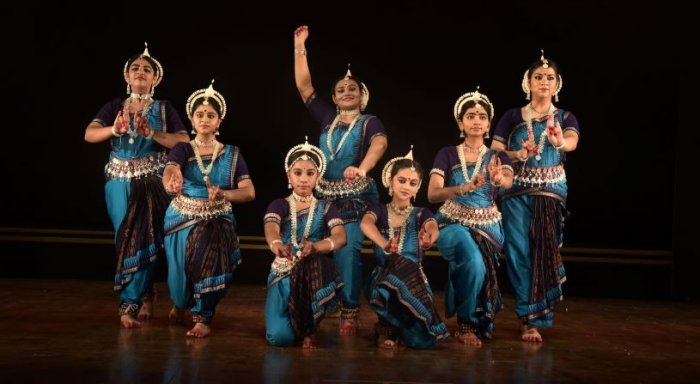 Panchabhuta 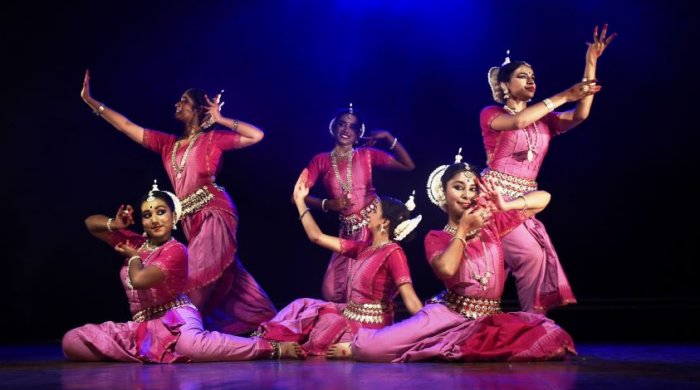 Malhar Pallavi 'Pallavi' is a form of pure dance of lyrical beauty, which lays equal emphasis on melody and rhythm. Pallavi which means 'to grow', grows in pace and complexity as the dance progresses and great emphasis is laid on highlighting the tribhangis and chauka patterns of Odissi dance style with hand gestures and movements used in a non-narrative way. The beauty of the three beautiful Pallavis in ragas Janasammohini, Malhar (music by Bijay Kumar Jena and rhythm composition by Bijay Kumar Barik) and Darbari (Rajesh Kumar Lenka, dance choreography Madhulita), with each Pallavi being performed by different group of dancers, was noteworthy for the precision and coordination between the dancers . An interesting Oriya composition "Bajuchhi sahi bajare" performed by Anjali Raj Urs, speaks about the sakhi telling Radha about the villagers gossiping about her scandalous love affair with Krishna. The many scenes of interactions between the two were explored in detail, but the most memorable moment was Anjali's depiction of Radha bathing in the river. The joy experienced when the river water caresses her body, sighting of Krishna sitting on the kadamba tree that she sees in the reflection, passionate exchanges between the two that were visualised by the dancer through her sancharis, depicted the emotion of shringara in a very poetic manner. This was choreographed by Guru Gangadhar Pradhan and Aruna Mohanty and music set to raga Sudhadesi was composed by Bijay Kumar Jena. 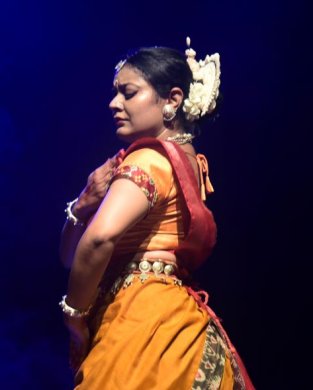 Anjali Raj Urs 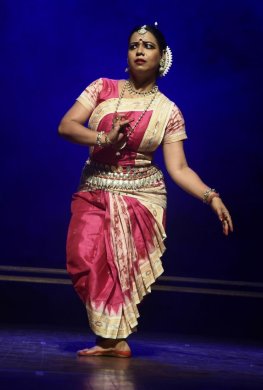 Sonali Mohanty Ashtapadis are such an integral part of Odissi repertoire, that no performance is complete without them. Sonali Mohanty chose to perform the popular ashtapadi "Dhira samire." The dialogues and interactions between the three pivotal characters here - Radha, Krishna and Sakhi - was portrayed with sensitivity by the dancer through appropriate stances and abhinaya to communicate the varied emotions. This was choreographed by Madhulita Mohapatra, with musical composition by Bijay Kumar Jena. Choreographed by Sahana Das, Oriya song "Uthilu ede regi kahinki re" highlights the harassment mother Yashoda faces at the hands of mischievous Krishna. Meghna Das delineated the travails of the mother trying to make her son go to bed and the mischievousness of the lad in thwarting every attempt, by alternating the emotions between the two with great finesse. Musical score was by Binod Panda. These three solo performances brought in moments of tranquillity between the narrative and fast paced nritta based compositions. 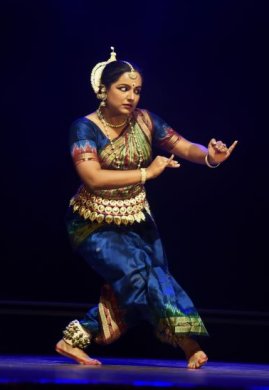 Meghna Das 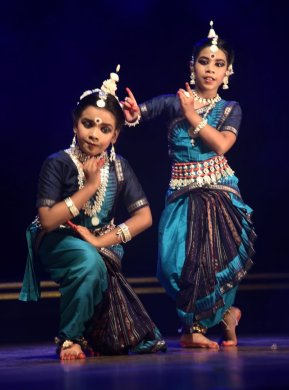 Kede chanda janilo 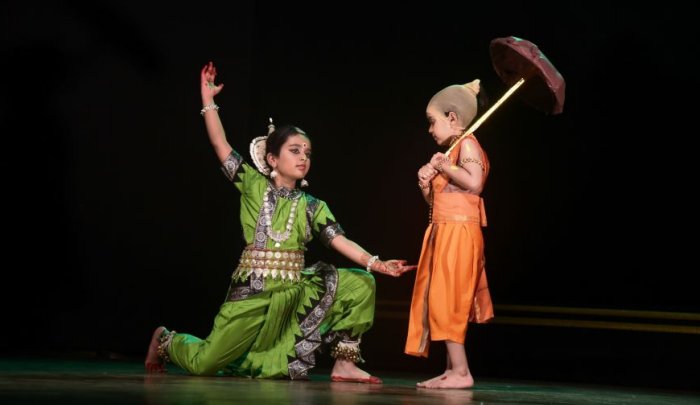 Vamana Avatar 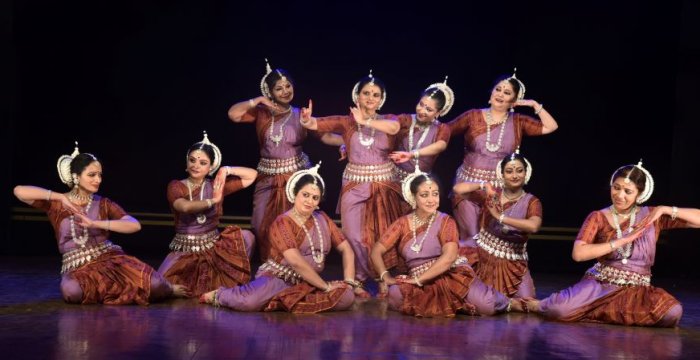 Madhurashtakam The level of confidence that young children displayed dancing on stage was visible in two songs. One was a small Oriya composition "Kede chanda janilo sahi" on leelas of Krishna, charmingly danced by Saanvi Sahoo and Sushmita Dhal and the other a cute depiction of Vamana avatar story by Maya Raj Urs and Mrida Raj Urs. On the other end of the spectrum were women who had come back to pursue their passion for dance after years of domesticity. They highlighted the beautiful form of Krishna in saint philosopher Shri Vallabacharya's composition "Adharam madhuram." Dancing with perfect synchrony, rhythm and grace, these women navigated varied group formations with finesse. Music was by Harihar Panda and choreography by Pankaj Charan Das. The enthusiasm, passion and effort that Madhulita Mahopatra and every dancer in her school had invested for this festival, elevated the performances to a level that moved beyond an annual day routine. NAMAN FESTIVAL 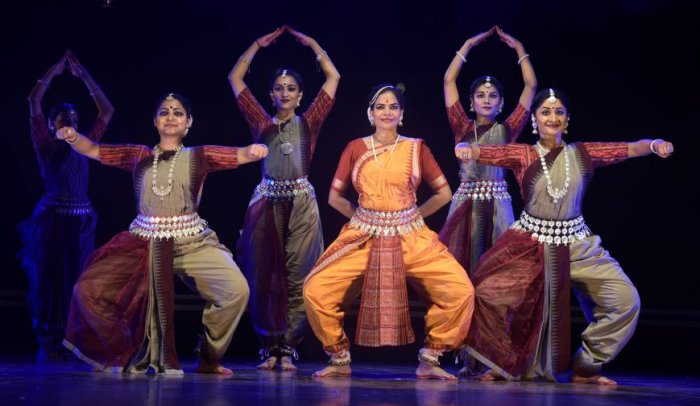 Colours of Krishna The second day was dedicated to showcase Odissi dance by professional performers. Madhulita and her dance ensemble presented 'Colours of Krishna,' a group choreographic work. The narrative depicted the all too familiar stories from the life of Krishna, but the manner in which Madhulita had choreographed the sequences in this sleek presentation made the whole experience of watching it, a pleasurable one. The Radha-Krishna interface danced by Madhulita and Paridhi Joshi, captured the emotions of love, anger, distress, disenchantment in an aesthetic way. The dramatisation of the Kaliya episode came through powerfully. The costumes, music (Rupak Kumar Parida), rhythm (Daneshwar Swain), dance compositions and lighting design blended seamlessly. 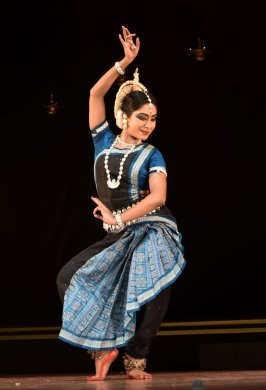 Preetisha Mohapatra Preetisha Mohapatra, a young talented dancer hailing from an illustrious lineage is blazing a trail as a promising soloist of Odissi style. She began her performance with Chandrakosh Pallavi in Panchasaviri tala. Set to a time cycle of 15 beats divided into 4-3-4-4, this Pallavi has been choreographed by Ratikant Mohapatra and music composed by Pradip Kumar Das. The young dancer's penchant for portrayal of characters with sensitivity and sensibility, was evident in her delineation of Ravana in the Sita Swayamvaram sequence, for sant Tulsidas's composition "Thumak chalat Ramchandra." The pride and arrogance seen on his face at the outset, slowly transforming to embarrassment when he finds the onlookers jeering him as he is unable to lift the bow, the anger that he feels at his failure and his walking away in shame was expressed with finesse by Preetisha. 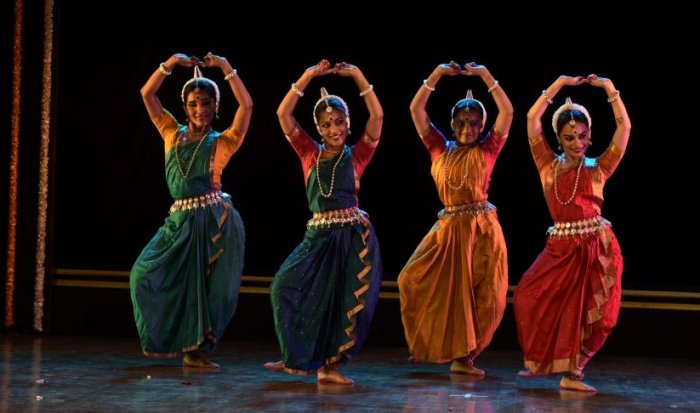 Nrityagram ensemble Nrityagram, India's first modern gurukul of Independent India, one of a kind community living for pursuit of dance, established by Protima Gauri, has gained stature for maintaining high standards of excellence in all aspects of Odissi. Presenting a few items as a part of this festival, the ashtapadi "Yahi Madhava" danced by Pavithra Reddy, danced with understated abhinaya, was impressive. Joy, verve and humour in the narration of the form of Ganesha and anecdotes from his story was ideated and danced in an interesting manner. It was only in the Shankarabharanam Pallavi which was presented at the outset, the stances and coordination of movements between the dancers fell short of the high standards they are known for. Besides an informal interactive session between the guests of honour and students of Nrityantar, the well planned and executed event had a Dr Sunil Kothari Memorial colloquium 2023 in collaboration with Mount Carmel College. Coordinated by Sahana Das, the speeches and panel discussion had experts talking about varied aspects of Indian classical dance. 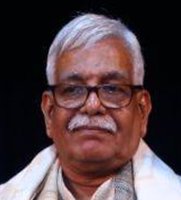 V.V. Ramani is a Chennai based multi-dimensional artist working in diverse fields ranging from collages and painting, teaching art, textile and costume designing, stage sets designing and wedding decor, to writing on visual and performing arts. |